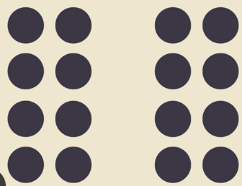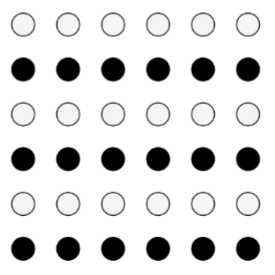Cognitive psychology full semester review
1/165
Earn XP
Description and Tags
Name | Mastery | Learn | Test | Matching | Spaced |
|---|
No study sessions yet.
166 Terms
With regard to the “man who” arguments described by Nisbett and Ross (1980)…
A. we make these arguments because of our assumption that categories are
heterogeneous.
B. they are not sound even when the whole category closely resembles the
single instance.
C. they reflect our willingness to take a small sample of data as seriously as a
larger sample.
D. we make these arguments because we extrapolate from what we know of
an entire set to a single case.
C: The “man who” arguments reflect our willingness to take a small sample as seriously as a larger sample
Heuristics
Strategies that are reasonable, efficient, and work most of the time (quick and dirty!) to make decisions. But, they can also lead to more errors sometimes
Availability heuristic
We judge frequency by assessing the ease at which examples of it come to our mind
—Events that are more easily remembered are judged as more probable
Representative heuristic
We judge frequency or likelihood by the extent to which it resembles the typical case
—based on the assumption that categories are homogenous and therefore each instance represents the whole category
Inductive reasoning
Drawing conclusions based on specific observations
→ this dog barks, so all dogs must bark
Deduction
Determining a conclusion based on what logically follows the premises
→ I know I don’t like headaches, and drinking gives me headaches, so I shouldn’t drink
Describe the Metcalfe & Weibe study about Gestalt Insight. What were the findings?
Participants are given insight problems, and problems that don’t require insight (algebra, well-defined), and measured the confidence levels of the participants every 15 seconds.
They saw that confidence levels shoot up very quickly for the insight problems, and for the algebra condition, the confidence levels increased steadily throughout → so when insight is used, it is really sudden.
They also looked at the insight jumps for when they got the correct and wrong answers, and saw that they were the same. → Insight only give any answer, not necessarily the right answer
Which of the following statements about problem solving is most
Likely to be true?
a. Incubation effects have been reliably found in every single study.
b. The "aha" experience implies only that we've discovered a new
approach to a problem, not that we've discovered the right solution.
c. Incubation always works, as it allows people to work on a problem's
solution unconsciously until it is ready to reenter consciousness.
d. The pattern of warmth ratings for insight and noninsight problems is
the same.
B: The “aha” experience only implies that we’ve discovered a new approach to a problem, not that we’ve discovered the right solution
The water-jar problem, in which participants are given three jars of
different sizes and must use those jars to come up with a certain
volume of water, has been used to demonstrate
a. functional fixedness.
b. incubation.
c. illumination.
d. Einstellung (attitude).
D: The 3 water jugs problem is used to demonstrate Einstellung / Attitude
when you have to do many water jug problems and practice them, and then are given an easier way of doing it, most ppl wouldn’t use the new easier way (bc we are stuck in our attitude ideas)
In the “Tower of Hanoi” problem, the rule that larger discs
cannot be placed on top of smaller discs would be considered…
a. an operator.
b. a path constraint.
c. a goal state.
d. an initial state.
B: the rule that larger discs cannot be places on top of smaller disks would be considered a path constraint
In the Gick and Holyoak paradigm (1980), participants were required to solve the "radiation problem." The group who were most likely to solve it were the participants who….
a. read the "Fortress" solution prior to reading the "radiation problem”.
b. had encountered other problems about tumors that were unrelated to the current problem in deep structure.
c. read the "Fortress" solution and were told to apply it to the "radiation problem”.
d. just read the “radiation problem”.
C: The group most likely to solve it was the participants who read the “fortress” solution and were told to apply it to the “radiation problem”
Chess experts are better at remembering chess positions than novices because they….
Experts use chunking strategies.
They are more deeply familiar with the material,so they can chunk and memorize things easier
What is the difference between a well-defined and ill-defined problem?
A well-defined problem has a set of procedures that would bring you to the solution, while an ill-defined problem might not have a clear path on how to find the solution
What is functional fixedness?
The inability to use an object for something other than how it is usually used
What is a problem-solving set?
a collection of beliefs and assumptions that a person makes about a problem
True or false: Functional fixedness is an example of a problem-solving set
True. Functional fixedness is an example of a problem-solving set.
→ assumptions that things cannot be used for unusual purposes is a way of thinking about the problem
What is the information-processing approach for problem-solving?
problem-solving is a search of information for the solution
What is the hill-climbing strategy?
At every decision, you chose what will bring you a bit closer to your goal, without knowing if it will take you all the way to the goal in the end
What is the problem with the hill-limbing strategy?
Some solutions require you to move away from the goal before moving forwards, but this strategy would not allow for that
What is means-end analysis?
Compare your current state with your goal state. If they are different, identify why, and then break this down into smaller goals. This way, every time you complete a small goal, your current state is a little bit more similar to the goal state.
What is analogical transfer?
For problem solving, analogical transfer is transferring information or solutions you know about a source problem to the target problem
True or false: Spontaneous use of analogies to solve problems is decently common
False: Spontaneous use of analogies is rare.
This is likely bc people focus on the surface features of a problem, and ignore the deep structure of the problem (the part that corresponds in an analogy)
What are the three steps of an analogical transfer for problem-solving?
Noticing the similarities between the problem and a past problem you’ve encountered
To do this, you must have paid attention to the deep structure of the problems
Mapping the corresponding aspects of the source problem onto the target problem
Applying the analogy using the map to solve the target problem
How does restructuring apply to problem solving?
Reorganizing your brain’s representation of a problem until it is formed in a way that helps find a path to the solution
What is insight?
Sudden realization of a problem’s solution
What are Wallas’ 4 stages of problem-solving?
Preparation: gather all the information for the problem, and start initial thinking.
This takes a lot of time and is often the most effortful step
Incubation: set the problem aside and let it sit. You will think unconsciously about the problem
motion usually helps incubate bc you’re literally getting your blood/brain flowing
Illumination: this is when insight happens and the lightbulb turns on
Verification: trying to verify the solution
True or false: Insight is only a predictor of having an answer, not necessarily the correct answer
True. Insight will look the same whether it leads to the correct or incorrect answer
Does incubation always help?
No, sometimes incubation is ineffective
How does the mutilated checkerboard problem pose an issue for the problem-space theory?
The problem space theory suggests that if the problem space remains the same, so should the level of difficulty of the problem.
However, when you change the look (color, words, etc), you are keeping the same problem space (possible paths) but the problem gets easier to solve
Why does the bread-butter mutilated checkerboard help people solve the problem the most?
Bread-butter helps point the participants towards the correct representation of the problem. It shows the stark difference in the kinds of squares, and that this cannot be changed
What is the bounded rationality theory?
Humans try to make rational decisions, but our cognitive limitations prevent us from doing so all of the time
Which of the following is FALSE with regard to the draw-a-person test study on illusory correlations?
A. college students with no prior training perceived illusory correlations between the features of the drawings and the respondent characteristics
B. professionals with training and experience perceived illusory correlations between the features of the drawings and respondent characteristics
C. the illusory correlations perceived by untrained college students were identical to those perceived by professional clinicians
D. college students and professionals found real correlations between the features of the drawings and respondent characteristics
D - college students and professionals both found correlations, that were identical, but these correlations were not real.
What does the orbitofrontal cortex do?
The orbitofrontal cortex predicts our emotions in future or hypothetical situations.
It is good at predicting how we will feel
It is bad at predicting how strongly we’ll feel that way, and how long predicted feelings will last
Participants with damage in the orbitofrontal cortex….
A. are still able to react to emotional stimuli and can still make decisions
B. are still able to react to emotional stimuli but are indecisive
C. are not able to react to emotional stimuli but can still make decisions
D. are not able to react to emotional stimuli and are indecisive
D — Patients with damage in the orbitofrontal cortex don’t show emotional reactions and can’t make decisions very easily (bc they can’t predict how they’ll feel)
Reason-based choice
We predict how we will emotionally feel about a decision and each option to inform our choice.
Our goal is to make decisions that we feel good about and that we won’t regret
When we are facing a sure win: _______.
When we are facing a sure loss: _______.
When we are facing a sure win: risk aversion.
When we are facing a sure loss: risk seeking.
Errors in reasoning about conditional statements, as in the four-card selection task, are LESS common when….
A. the statements diverge from one’s prior beliefs
B. problems are abstract rather than related to our lives
C. the problems are easy to memorize
D. the problems are taken from our lives rather than being abstract
Errors in reasoning about conditional statements (like in the four-card task) are less common when the problems are taken from our lives rather than being abstract
responses on the four-card selection task were almost always wrong when it was letters and numbers. When they were drinks and drinking age, something related to normal life, they were much more accurate
Which of the following is false regarding the reason-based choice approach of decision making?
A. the approach claims that we try to make rational decisions, but cognitive limitations prevent us from being rational
B. the approach claims that we try to predict the regret we will feel having make a certain choice
C. the approach claims that we try to make decisions that we will feel good about
D. this account can explain why we are risk aversive in terms of wins and risk seeking in terms of losses
A is false — it is instead the definition of the bounded rationality theory
The Metcalfe & Wiebe studies of insight showed that insight is indeed ______, and that it _______ indicative of the correct solution
The Metcalfe & Wiebe studies of insight showed that insight is indeed sudden, and that it is not indicative of the correct solution
It only shows that an answer has been found, it may not be the correct answer
The strategy whereby one breaks down a large problem into smaller subproblems is called….
means-end analysis
Break your plan into small steps, each one bringing your current state closer to looking like the final goal state
Regarding the use of analogies in problem solving…
A. students should memorize problems, as this will help them later to discover analogies for new problems
B. explicit hints about useful analogies are beneficial to problem solvers
C. people spontaneously make analogies between superficially different problems
D. to use analogies, people must prevent themselves from mapping one situation onto another
B — Explicit hints about useful analogies are beneficial to problem solving
the most difficult part of analogical transfer is noticing the similarities in problems (noticing that an analogy can be used), so hinting at this will be a great benefit
Which of the following is not a characteristic distinguishing experts in a particular field from novices in that field?
A. experts organize their knowledge more effectively
B. experts rely more heavily on means-end analysis
C. experts are more likely to use analogical problem solving, as they focus on the deep structure of the problem
D. experts have more knowledge than novices in their domain of expertise
B — means end analysis would focus more on small physical changes, whereas experts focus more on deep structure and would be better at analysis-type things, such as analogical transfer
Which of the following is true about creativity?…
A. creativity may result from the correct combination of ordinary mental processes
B. people with highly creative minds know how to use incubation more effectively
C. people with highly reative minds are more likely to be mentally ill
D. for a solution to be considered creative, it only has to be “original”
A — Creativity may result from the correct combination of ordinary mental processes
like being internally motivated, risk-taking, good at taking criticism
It’s not D - for a solution to be creative, it must be novel but also have potential value
Creativity is related to…
A. mental illness, such that people who are more creative are also more likely to have mental illness
B. mental illness, such that people who are more creative are also less likely to have mental illness
C. latent inhibition, such that people who are more creative are also more likely to show increased latent inhibition
D. latent inhibition, such that people who are more creative are also more likely to show decreased latent inhibition
D — Creativity is related to latent inhibition, such that people who are more creative are also more likely to show decreased latent inhibition
Latent inhibition
The ability to screen out stimuli that are considered irrelevant (aka, selective attention)
reduced latent inhibition is related to mental illness and with creativity → they may not cause each other, but both be caused by the same underlying factor of LI
A group of experts in a specialized area was able to solve complex problems in their area pf expertise more effetively than a group of novices of equal general intelligence. Which of the following most plausibly explains the better performance of the experts?
A. the experts devoted more time initially to grasping the surface features of the problem
B. the experts had developed superior chunking routines for processing the specialized information
C. the experts had developed heuristics for reducing the speed of short-term memory decay
D. the experts had developed larger short-term memory capacities, both within and outside the specialized area
B — The experts had developed superior chunking routines for processing the specialized information
Experts don’t have any better memory than non-experts
(this is shown in the chessboard experiment. If the pieces are in a random orientation, the two groups remember them equally as well)
Which of the following is NOT true about Rosch’s prototype theory of category membership?
A. Judgments about an item are made with reference to the ideal/average of that category
B. In this theory, the boundaries of the category are specified, rather than the center of the category
C. Items that more closely resemble the prototype are perceived to be “better” members of the category than other items
D. It can explain typicality effects
B — In this theory, the boundaries of the category are specified, rather than the center of the category
This is false. The prototype theory specifies the central “average” of the category and has blurred boundaries
Which of the following is NOT an attribute of the prototype
theory?
A. Fuzzy boundaries
B. Sets of weighted features
C. Defining features
D. Gradedness of category membership
C—Defining features
Defining features are involved in the classic view of category membership. In the prototype theory, nothing is NEEDED 100% of the time for an object to be categorized a certain way
What is the exemplar theory of categorization?
To categorize a new instance, you compare it with the stored exemplars of that category in your mind, using our previous knowledge of the world to decide which features are important in this comparison
What is the prototype theory of categorization?
To categorize a new instance, we compare it to our created prototype member in our brains, assessing to what degree they are similar
What is the classic theory of categorization?
To categorize a new instance as part of a group, it must have ALL of the defining features in that object’s definition to be a member in that category.
Research shows that children are willing to make suggestions
about how to turn a toaster into a coffee pot but deny the
possibility of turning a skunk into a raccoon. This is evidence that…
A. Category membership and typicality ratings can diverge.
B. Category membership is influenced by knowledge about
underlying properties (i.e., the essence of the category).
C. Our use of categories is dictated by typicality.
D. Children and adults have radically different understandings of
categorization.
B — Category membership is influenced by knowledge about
underlying properties (i.e., the essence of the category).
This exhibits psychological essentialism, which relies on our knowledge and beliefs about the general world and categorization
Is membership in a category black/white or graded in the classic view? What about in the prototype view?
In the classic view, membership is black/white based on if the object meets all of the defining features.
In the prototype view, membership is graded, and the lines between categories are blurry and not well defined
Describe the Keil study. What was done, and what was found?
Preschool children were asked “Can you turn a toaster into a coffee pot?” and responded yes, but when asked “Can you turn a raccoon into a skunk?” they responded no.
This shows psychological essentialism: the belief that members of a category have an unseen property that causes them to be in the category, and this usually only applies to natural/organic categories
This also shows that psychological essentialism is an innate belief, since it exists in these young kids without having been taught
In a sentence verification task, which of the following sentences
would produce the SLOWEST response time?
A. A robin can fly.
B. A robin is a bird.
C. A robin is an animal
D. A bat is a bird.
D — A bat is a bird
The longest search is one that is a failed search. To reach the conclusion that a bat is not a bird, you must search your entire brain for a connection between bat-bird first, before coming up empty-handed
Human children and apes trained on language capaity…
A. aquire language with the same ease
B. are equally creative and playful with language
C. differ in their usage of language. For example, apes mainly use it to get things
D. master complex syntax equally well
C — Apes and children differ in their usage of language. For example, apes mainly use it to get things
Patient A: "I . . . w-w-w- . . . went . . . um . . . th."
Patient B: "Then, the zoo did very wildly to him, and before all he
then did again to her. It did too him and her and them and all from
here."
Patient A probably suffers from damage to _______ resulting in a
_______ aphasia. Patient B probably suffers from damage to
_______ resulting in a _______ aphasia.
a. Broca's area, receptive; Wernicke's area, expressive
b. Wernicke's area, receptive; Broca's area, expressive
c. Broca's area, expressive; Wernicke's area, receptive
d. Wernicke's area, expressive; Broca's area, receptive
C
Broca’s aphasia is also known as ____ or ______ aphasia
Broca’s aphasia is also known as nonfluent or expressive aphasia.
Wernicke’s aphasia is also known as ____ or _____ aphasia
Wernicke’s aphasia is also known as fluent or receptive aphasia
A person with Broca’s aphasia (aka ___/___ aphasia), will have ____ grammar skills and _____ comprehension
A person with Broca’s aphasia (aka nonfluent/expressive aphasia), will have poor grammar skills and good comprehension
A person with Wernicke’s aphasia (aka ___/___ aphasia), will have ____ grammar skills and _____ comprehension
A person with Wernicke’s aphasia (aka fluent/receptive aphasia) will have good grammar skills and poor comprehension.
True or False: membership is graded in both the prototype and exemplar models of categorization
True. In both the prototype and exemplar theories, membership is graded and there are no hard lines or cutoffs.
What determines typicality?
Feature frequency: holding more of the frequent features of the category than other members
True or False: Prototype theory predicts that typicality and category membership will always go hand-in-hand
True. If something is typical of a category, this theory assumes that this object is a member of the category (this is a fault of the theory — this isn’t always the case)
Which of the following is true about the hierarchical semantic network?..
A. It stores all information about a member with the member
B. It predicts a typicality effect for response times in the sentence verification task
C. It has problems explaining association effects on response speed in the sentence verification task
D. Information can be retrieved in parallel from all levels of the network
C. The hierarchical semantic network has problems explaining association effects on response speed in the sentence verification task
What is the association effect?
When we associate a certain member with a category or attribute more heavily or strongly, and this makes us quicker to verify that the object is a member of that category
—Ex: We would be quicker to verify that a peacock has feathers than a robin, even though they are both birds and an equal # of semantic connections away from “feather”
Which of the following is not true…
A. “m” is a phoneme and never a morpheme
B. “s” is a phoneme and never a morpheme
C. the word “wish” contains 3 phonemes
D. the word “walked” contains 2 morphemes
B. Yes “s” is a phoneme, but it can also be a morpheme when added to the end of a word to make it plural
Nativists assume that….
We are born with a special language-learning device. Therefore, language and cognition are independent.
Anti-nativists assume that…
We are born with a general-purpose learning device. Therefore, cognition and language are connected
Nativists assume that…
A. we are born with a genera;-purpose learning device than enables us to learn language
B. we are born with a learning device speific to language, that stores information about the details of each and every language in the world
C. language and cognition are intrinsically interlinked, i.e., they are not independent capabilities
D. language and cognition are independent
D: Nativists assume that language and cognition are independent
A patient with fluent but meaningless speech and problems with comprehension most likely has damage in the left ____ and should be diagnosed with _____’s aphasia
A patient with fluent but meaningless speech and problems with comprehension most likely has damage in the left posterior temporal lobe and should be diagnosed with Wernicke’s aphasia
Which of the following is fals
Broca’s area is in the left ____ ______ ____, and Wernicke’s area is in the left ____ ____ ____
Broca’s area is in the left inferior frontal cortex, and Wernicke’s area is in the left posterior temporal lobe
Bilinguals…
A. only show lexical competition from both languages in situations where the speaker mixes these languages within a sentence
B. have worse cognitive control skills than monolinguals, since they always need to allow words from both languages to compete
C. seem to have better cognitive control outside of the language domain
D. only have better cognitive control when it comes to language
C: Bilinguals seem to have better cognitive control outside of the language domain
What is the strongest version of language determinism?
Language determines thought.
What is the weaker version of language determinism?
Language affects only perception
What is the weakest version of language determinism?
Language only affects processing on tasks where linguistic encoding is important
What is vocabulary differentiation?
The idea that languages differ in their vocabulary capacities.
— Some cultures have single words available for concepts that other languages take many words to describe
The photoreceptors called rods are good for navigating in what kind of environment?
a. dimly lit
b. one in which color discrimination is vital
c. one in which noises need to be finely discriminated
d. one in which fine visual detail is important
A. dimly lit
Fill in the blanks with: bipolar calls (B), ganglion cells (G), Photoreceptors (P)
Light passes into the retina first through the x, then the x before arriving at the x.
Visual processing starts at the x which then activates the x and then activates the x
Light passes into the retina first through the G, then the B before arriving at the P.
Visual processing starts at the P which then activates the B and then activates the G
The visual pathway from the occipital-parietal cortex is responsible for…
Responsible for the locations of objects. Called the “where” system.
The visual pathway from the occipital-temporal cortex is responsible for…
Responsible for identification of objects. called the “what” system
In an experiment designed to test the receptive field of a center-suround cell, a stimulus was placed in a certain location, and the firing rate of the cell decreased. This most likely occurred because the stimulus was located…
The stimulus was entirely in the surround of the cell’s receptive field
How do you calculate the perceived distance of an object?
Perceived distance (m) x size of retinal image (mm)
How, according to Helmholtz, do we achieve size
constancy through unconscious inference?
There is an unconscious calculation of the size of the retinal image and the distance away the object is, which arrives us to the perception of the actual size of the object.

Which gestalt principle do we use to perceive this figure?
Closure

Which gestalt principle do we use to perceive this figure as two groups of dots and not 16 dots?
Proximity

Which gestalt principle do we use to perceive this figure as rows of dots instead of many dots, or columns?
Similarity

Which gestalt principle do we use to perceive this figure as two crisscrossing lines?
Continuity

Which gestalt principle do we use to perceive this figure?
Simplicity

What are the 5 Gestalt principles of organization we discussed in class?
Closure, simplicity, continuity, proximity, similarity.
In apperceptive agnosia, object recognition is impaired bc of deficits in_____
Perceptual processing
In associative agnosia, object recognition is impaired bc of difficulties_____
Accessing knowledge about objects stored in memory
A patient with associative agnosia would…
a. be able to name objects
b. be able to copy and match figures
c. have damage in the visual “where” pathway”
d. recognize objects but feel unfamiliar with them
B. A patient with associative agnosia would be able to copy and match figures
Why is a high-frequency word recognized faster than a low-frequency word?
A high-frequency word has a higher resting level than the low frequency word, so it needs less stimulus to reach the threshold.
Which of the following is true about the recognition of inverted faces?
A. recognition of inverted faces is harder than for upright faces
B. face processing is affected only minimally by inverting the image
C. Inverting a nonliving object, such as a house, produces a bigger deficit in recognition than inverting a face
D. recognition of objects that are not faces is not affected by inverting the image
A. Recognition of inverted faces is harder than for upright faces
____ driven priming requires resources, ____ driven priming does not require resources
expectation-driven priming requires resources, stimulus-driven priming does not require resources
What is the load theory?
When an attended stimulus is easier, more processing power is left for the unattended stimulus to be perceived. When the attended stimulus is more complex, there is less capacity left for the unattended stimulus and it likely won’t get processed.
What is the difference between Broadbent and Teisman’s early selection models?
Broadbent’s filter theory of attention: There is a bottleneck in attention, so only a certain amount of information can be processed. Stimuli are sorted by physical characteristics and the ones not chosen are fully blocked.
Treisman’s attenuation model: In this model, all stimuli are processed, and then all but one are “turned” down to focus all the attention on the attended stimulus.
In one unattended stimuli are blocked and never even processed, in the other they are simply not attended to.
What is inattentional blindness?
Not noticing something because you are attending to something else (and therefore not paying attention to other stimuli).